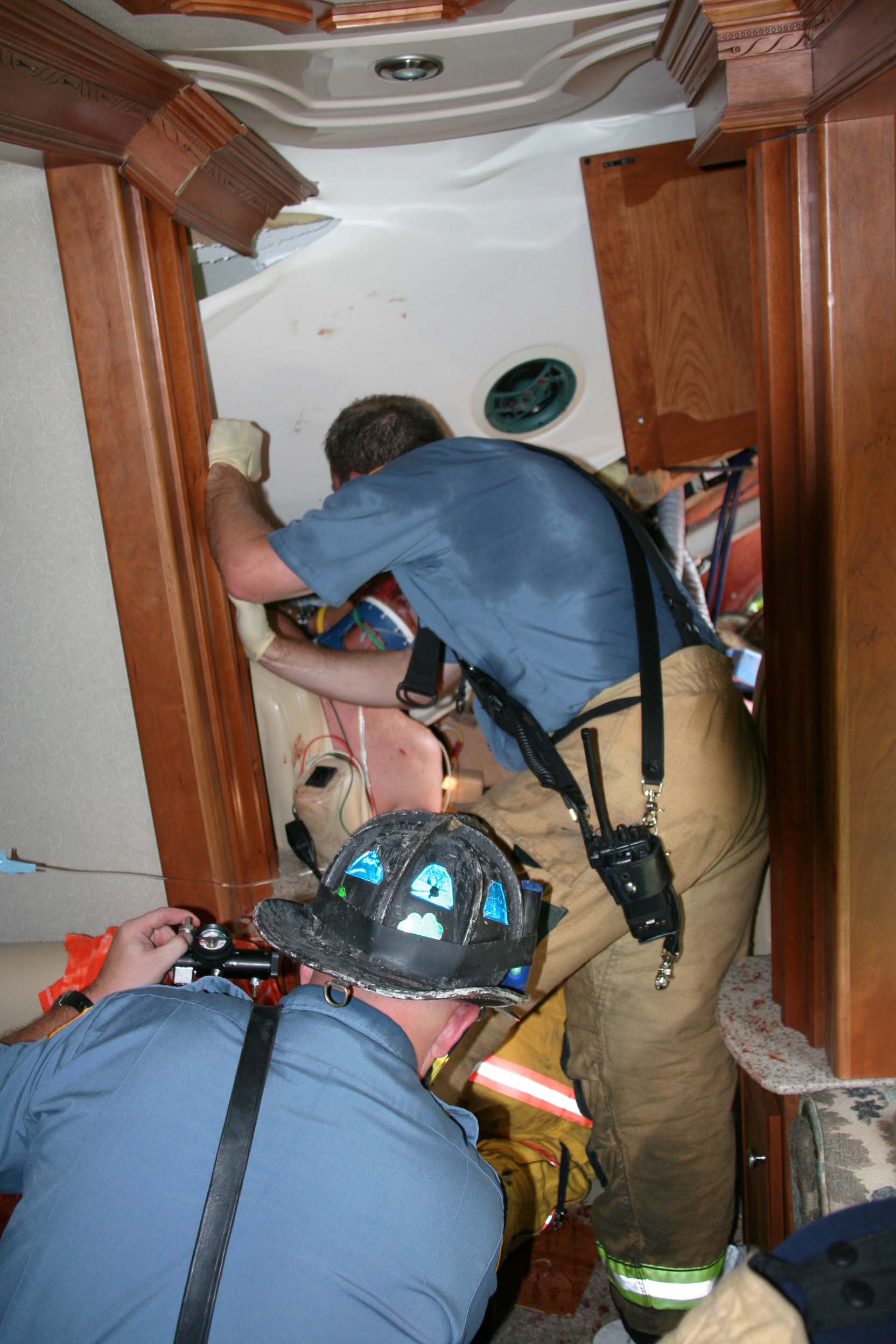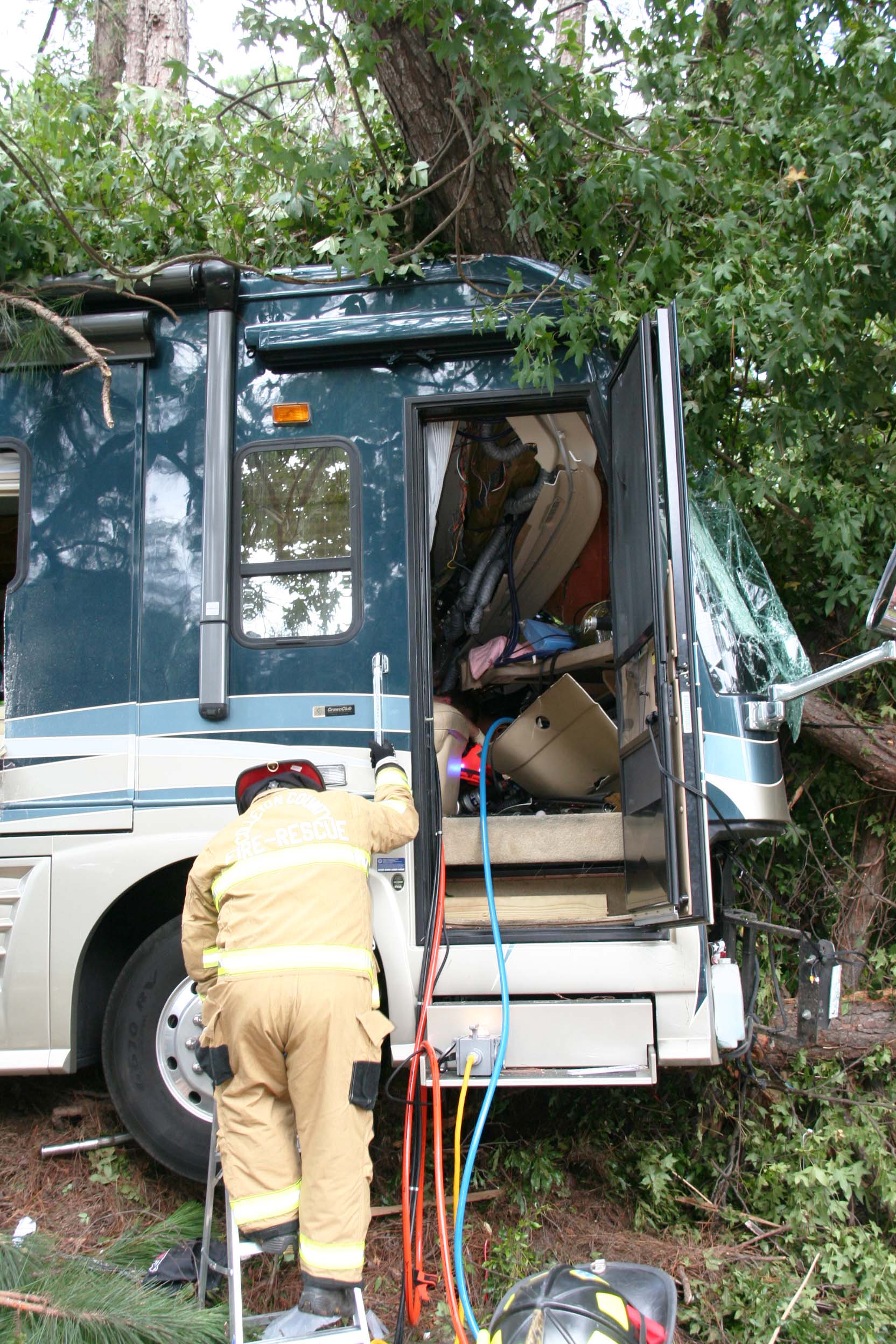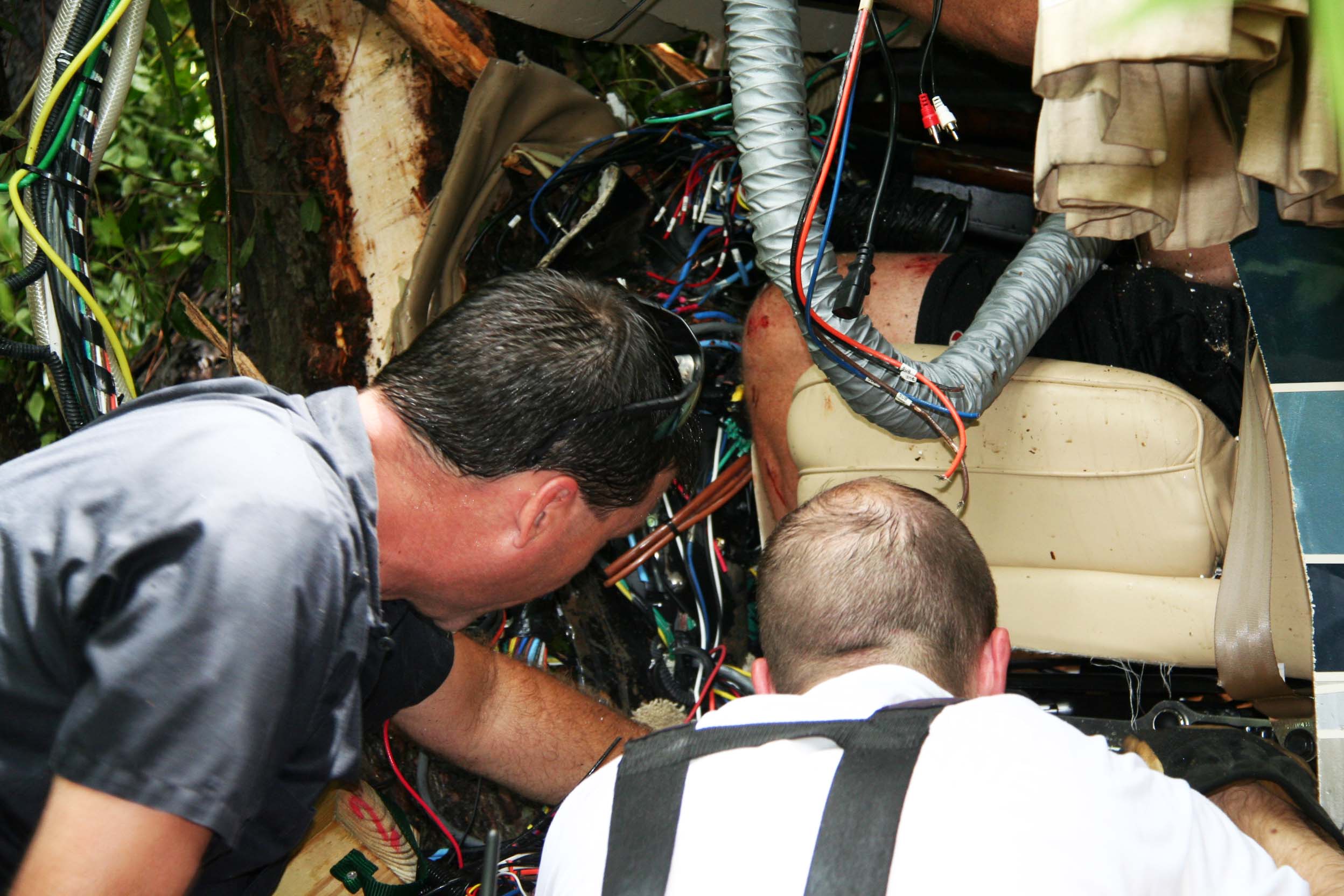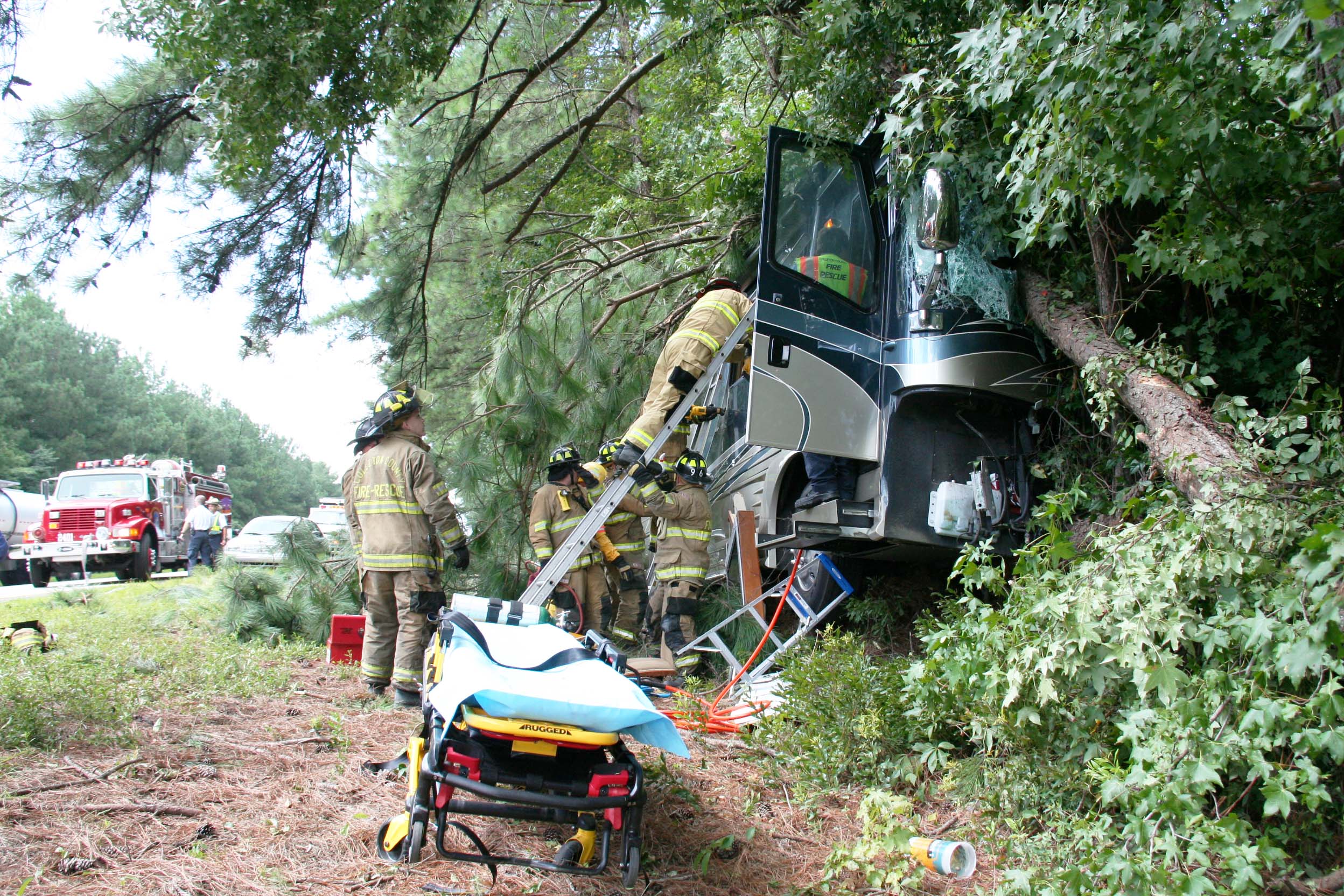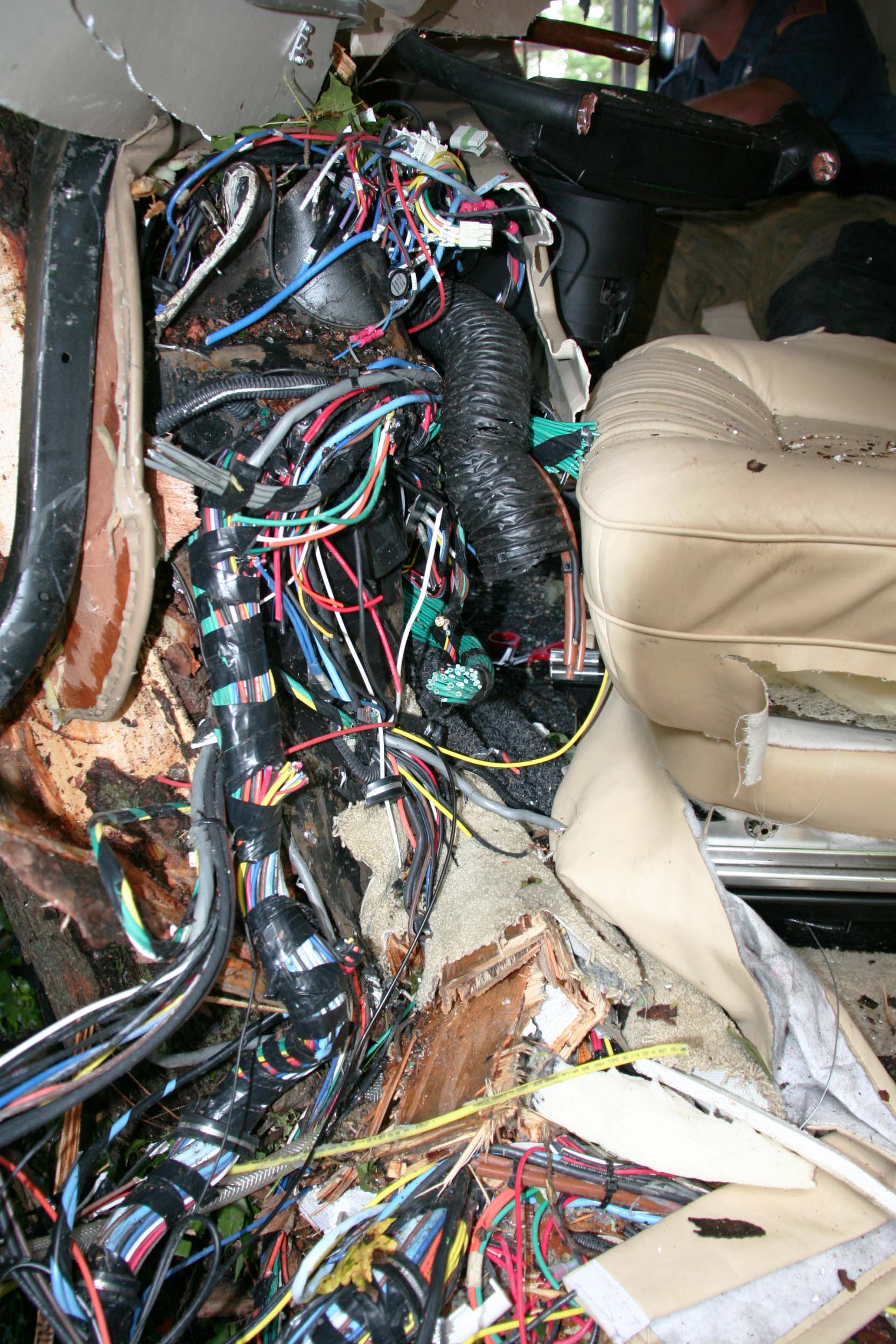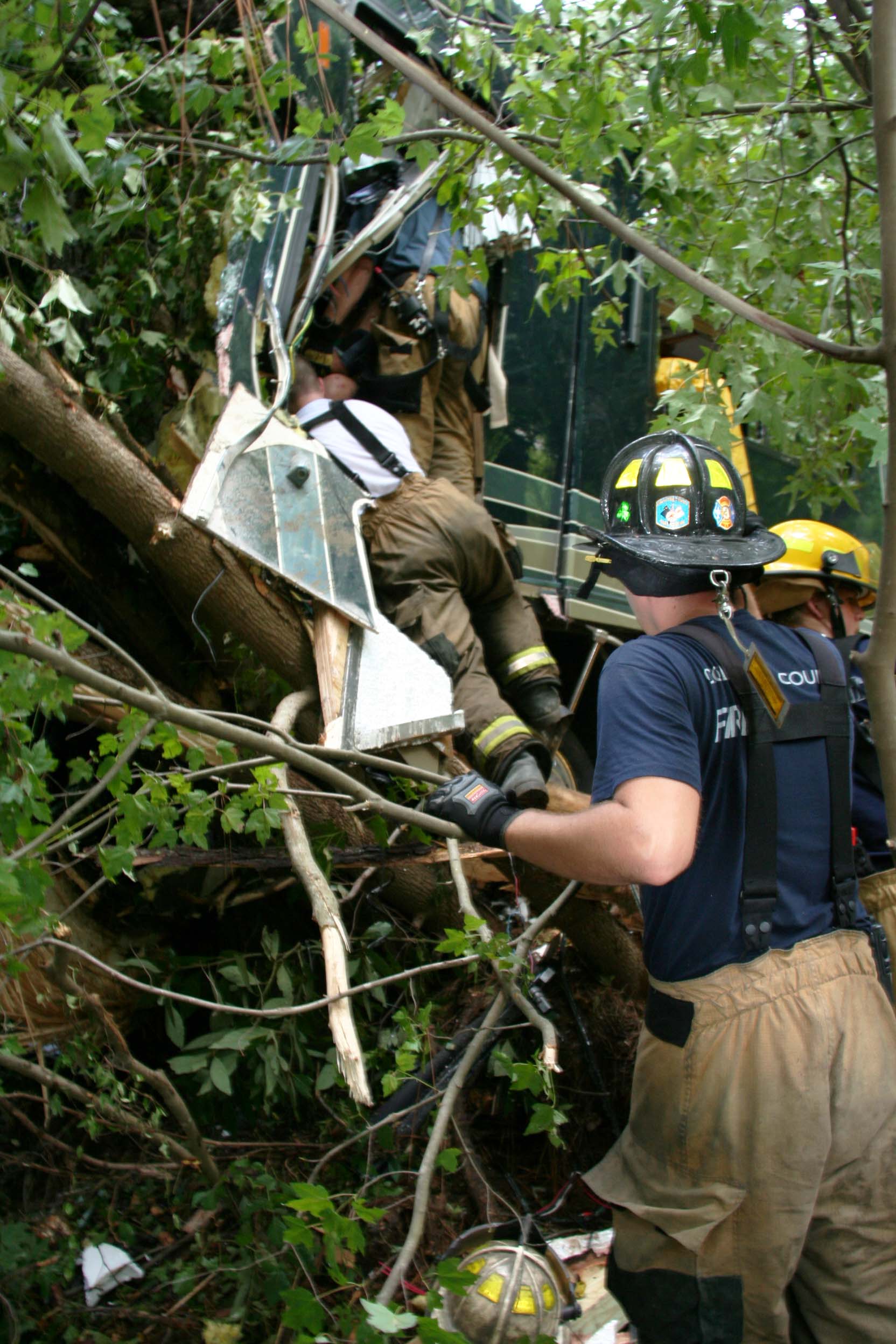
Stations 1, 2, 6, 19, 26 and 27
responded to a MVC with a challenging four and half hour extrication on
I-95 at the 53 mile marker northbound, Thursday morning 20-August at 1058.
Initial reports indicated a vehicle was off in the median and struck a
tree just south of the Sniders Highway (SC Hwy. 63) overpass. Engine 1 and
Medic 6 responded the 2 miles from Headquarters. A Sheriffís Deputy,
working interdiction on the Interstate, arrived within minutes indicating
a large motor home had struck several trees. He noted one patient was
trapped and two others were injured, with one patient being unconscious.
Medic 27, Rescue 1, Battalion 1 and a medical helicopter were then
assigned to the incident. Due to poor weather conditions throughout the
state, the only medical helicopter that could respond, was Omniflight from
Savannah, flying in from south of the incident.
On arrival of Engine 1, the crew reported a bus sized RV/motor home in the median with heavy damage, impaled on several trees. The cab portion was almost completely destroyed with little to no access to the interior from the cab. The passenger side entrance door was forced open, but provided little room to
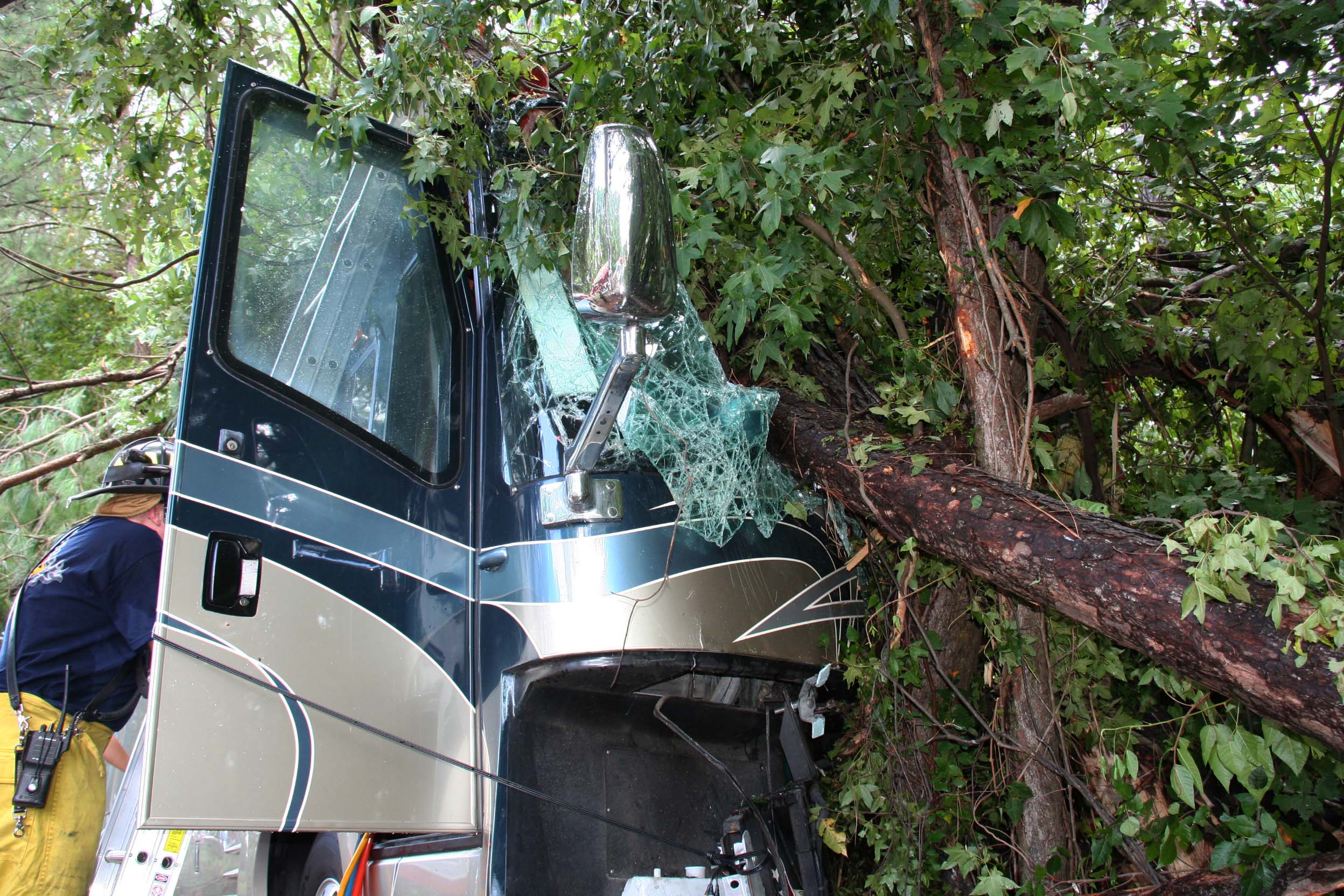
Emergency vehicles were positioned out of the collapse zone of the tree and one lane of Interstate 95 was closed as a precaution. This also allowed emergency crews room to operate in the closed lane. Two patients were in the rear portion of the coach. Both suffered non-life threatening traumatic injuries. One, who had been a restrained front seat passenger, was ambulatory, receiving only minor injuries. The second man, who had been sleeping, received more serious injuries, including several fractures. The driver was conscious, but heavily entrapped in the wreckage. The engine was located in the rear of the vehicle
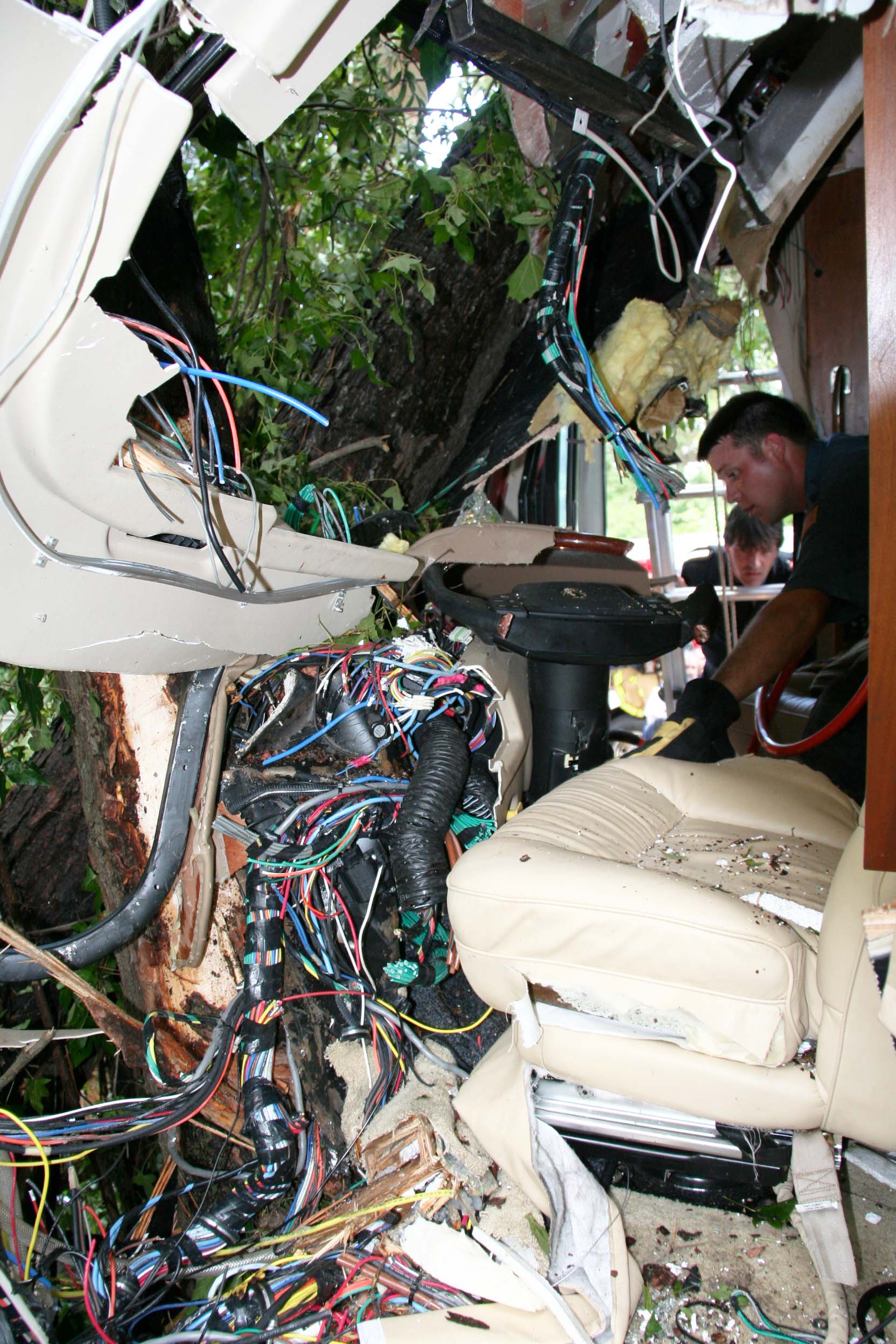
Access to the front of the vehicle was very limited. The entire front of the coach was blocked by large fallen trees, pushed up debris and brush. The driverís side was also blocked by trees, debris and brush. Crews laddered the passenger side of the coach and removed a large side window. Two reciprocating saws were used along with an Ajax Tool, to cut an opening in the side of the coach, enlarging the window. This provided a good access point for personnel and equipment, despite being eight feet off the ground. One patient was back boarded inside the vehicle and passed down to rescuers on the ground. The ambulatory patient was able to climb down the ladder, walking safely to Medic 6. Both patients were transported by Medic 6 to Colleton Medical Center in Walterboro. Firefighter-Paramedics had already been working on the driver. With the other two patients removed, this allowed personnel to begin clearing debris from inside the coach, making room for crews and equipment to operate. The midday heat and humidity just added to the already poor working conditions. Personnel were rotated out regularly to reduce fatigue and allow time for rehydration. A confined space ventilation fan was set up to circulate fresh air inside the vehicle.
Inside crews were able to establish an IV line on the driver. He was experiencing a great deal of pain. Crews administered narcotic analgesics regularly in an effort to ease his discomfort. Most of his upper body was accessible, but he was trapped from his waist down with his legs entangled in the wreckage, pinned by a large pine tree that was inside the cab. He was very fortunate the steering wheel was shifted to the center of the vehicle to the patientís right. Personnel began the tedious task of removing portions of the interior as they tunneled their way into the interior. The stability of the trees, which were broken off at ground level and resting on the bulkhead above their heads was of great concern. Moving the coach was the easiest extrication technique, but was impossible due to the fallen trees.
The extrication was obviously going to be an extended operation. The medical helicopter was directed to land at the helipad at Colleton Medical Center rather
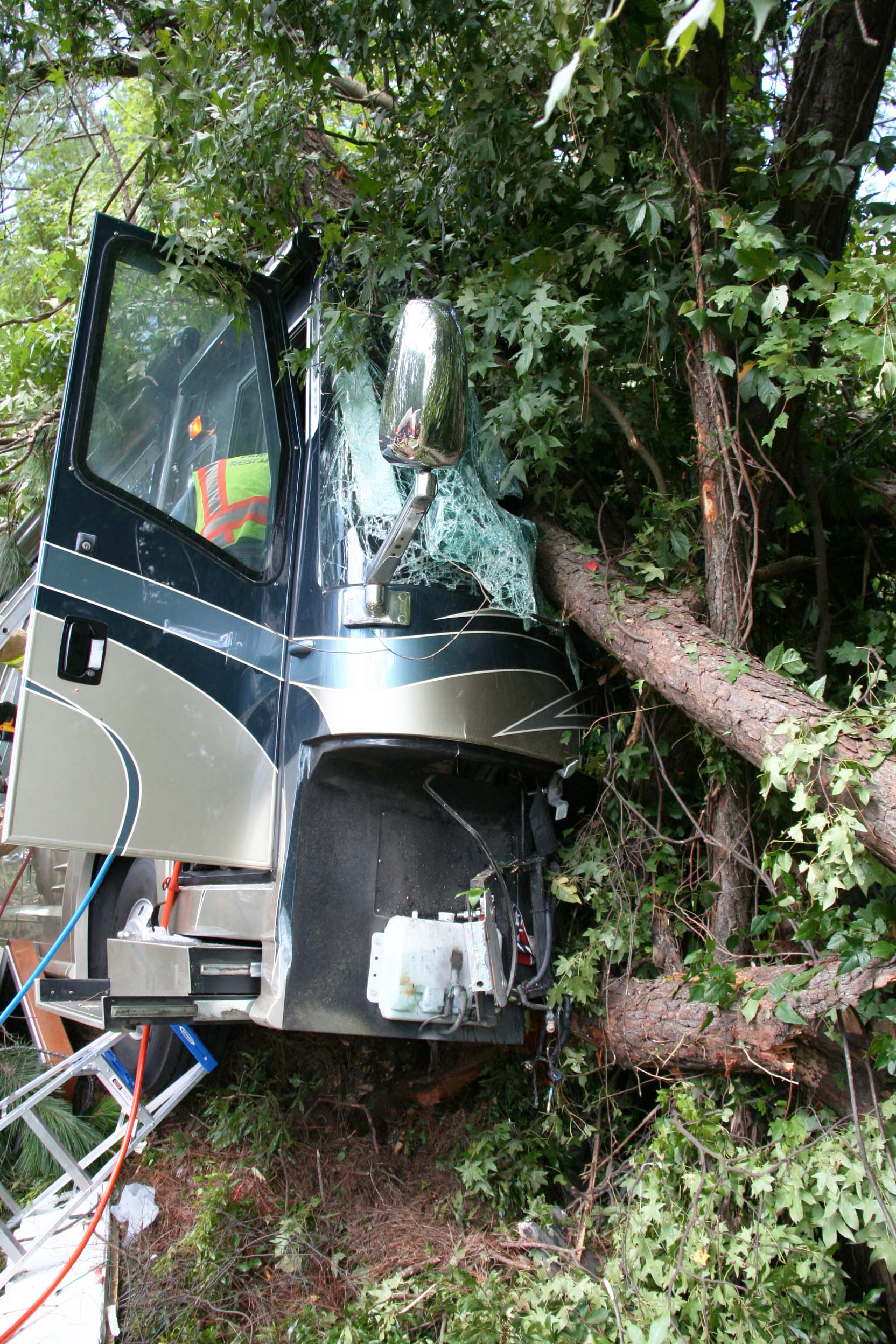
than the scene. This kept the one
lane of the Interstate open and in the event of a storm, the helicopter
would not be grounded on the highway. After landing at Colleton Medical
Center, the flight crew was picked up and transported to the scene where
they assisted with patient care.
Multiple Holmatro Rescue tools were used to cut, push, displace and/or move portions of the interior. Three sets were in operation at one point, with three spreaders, two rams and a mini-cutter inside the cab as well as power saws and hand tools. The driverís seat was pushed against the bulkhead between the cab and the living area from the impact. The front of the vehicle, dash and a tree occupied the few inches in front of the seat, along with the patientís legs. Crews worked for over an hour from the passenger side and from behind the driver. Coastal Electric Power Company was contacted and responded a boom truck to the scene. The power company truck was equipped with a hydraulic boom for installing power poles. It was hoped the boom could be used to remove the 50 foot pine tree from the vehicle. The boom performed well and was easily able to lift the tree; however the bottom of the tree was impending on other trees. The movement caused the other trees to exert pressure on the patientís legs causing increased pain. That effort had to be abandoned. The boom truck was left in position to insure the tree was stabilized.
Personnel then concentrated effort on the driverís side. Trees, brush and debris were removed to gain access to the vehicle. After approximately twenty minutes crews were able to use a reciprocating saw, Ajax Tool and Holmatro Mini-cutter to cut a large hole in the side of the RV. Debris was cut and removed from the interior, along with bundles of wiring, dash and roof panels. Several Holmatro hydraulic rams and cribbing were used in an effort to displace the dash and seat. This provided a few precious inches, but not enough space to remove the patients left leg. Crews on the passenger side of the vehicle had been successful in freeing the patientís right leg, but his left leg remained pinned. Being unable to move the coach presented many problems. The seat was pushed as far back as possible and it was impossible to move the tree. Crews continued to cut and remove small portions of the dash and front of the vehicle from the inside, until finally they were able to work his left leg free after nearly 4-1/2 hours. The patient, who remained conscious and stable during the entire operation, also provided assistance during his rescue. He even at times assisted in relaying messages from rescuers on each side of the vehicle and passing tools and equipment from one side to the other.
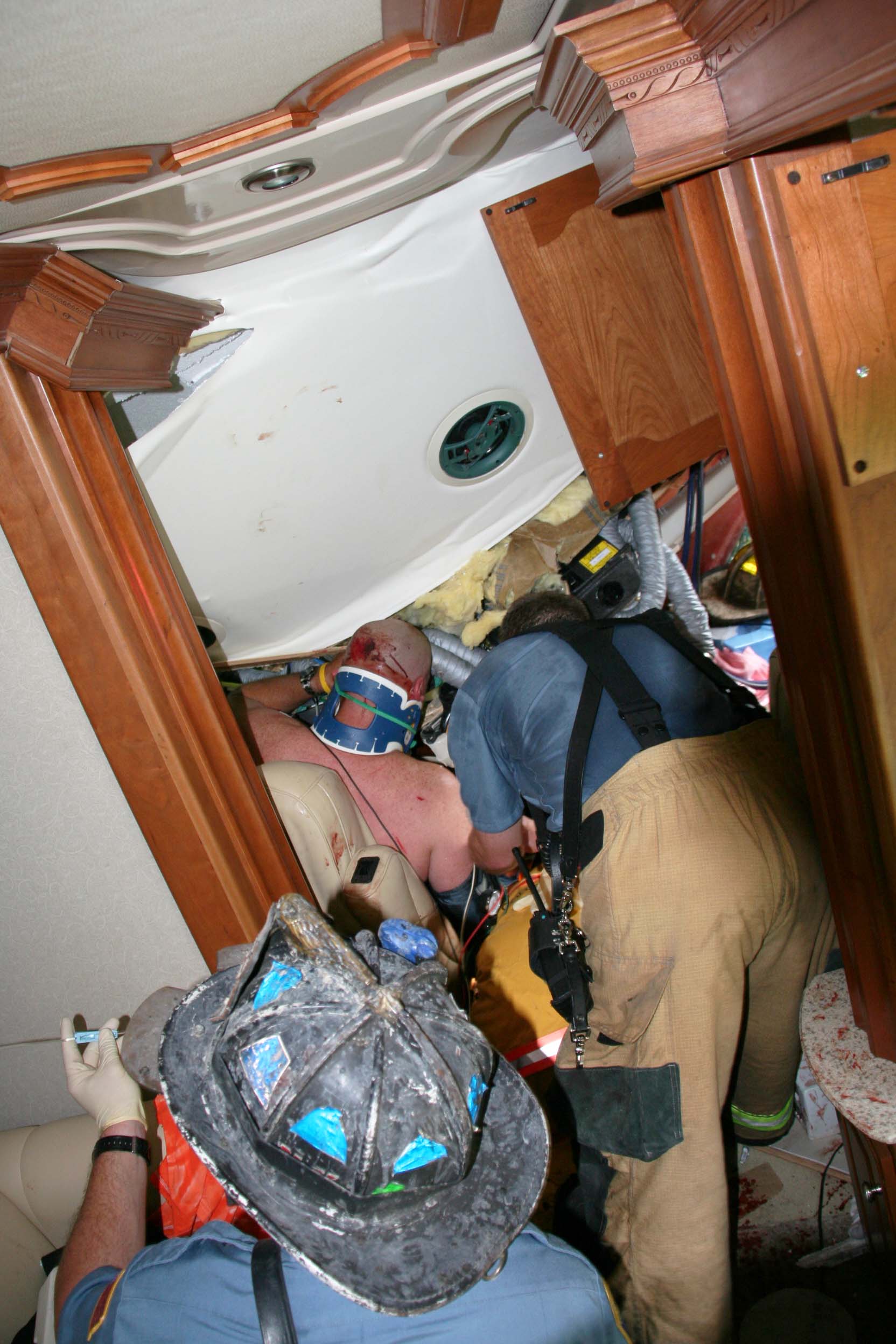
He was removed from the RV at
1558, transported to Colleton Medical Center in Medic 19, then flown to the
Trauma Center at Memorial Medical Center in Savannah Georgia. Due to poor
weather, the closest two trauma centers could not be reached by helicopter.
Twice during the extrication thunderstorms rolled through the area drenching
rescuers with heavy rains and winds, but at least cooling off the scene.
Following the incident, a Fire-Rescue officer stopped at a McDonalds
Restaurant to pick up food for personnel, all of whom missed lunch. A Good
Samaritan and his young son in line, who had been stuck in the traffic
caused from the accident, came forward and paid for the food. He thanked the
personnel for the hard work, noting that could have been his family needing
assistance. He felt it was the right thing to do. The man would not provide
his name, but the personnel were grateful for his generosity. Traffic on
I-95 remained backed up for hours.
